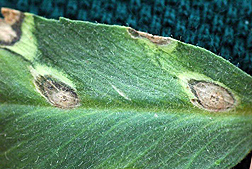This page has been archived and is being provided for reference purposes only. The page is no longer being updated, and therefore, links on the page may be invalid.
|
|
|
|
Fungus-on-Fungus Fight Could Benefit Chickpeas
By Jan SuszkiwDecember 4, 2009
The fungus Ascochyta rabiei threatens chickpea crops the world over. But now this blight-causing pathogen could meet its match in Aureobasidium pullulans, a rival fungus that Agricultural Research Service (ARS) scientists are investigating as a biocontrol agent.
Treating chickpea seed with fungicides, planting resistant cultivars, plowing crop fields before planting time, and rotating chickpeas with non-host crops are effective methods of controlling Ascochyta blight, which forms dark lesions on the legume crop’s stems, leaves and pods. According to ARS plant pathologist Frank Dugan, however, biocontrol is worth exploring for its potential to provide chickpea growers with greater flexibility in how they manage the disease.
During the winter, A. rabiei survives on chickpea stubble (stems and leaves left behind after harvest) and forms sexual spores, called ascospores, which can infect plantings of the crop in the spring. Severe outbreaks—fueled by cool, wet conditions—can wipe out the entire crop. But for all the damage A. rabiei inflicts, it, too, can be harmed.
In studies begun by Dugan and colleagues in 2003, a close examination of chickpea stubble from fields near Pullman, Wash., revealed a community of fungal competitors. Of 28 fungal isolates identified, A. pullulans scored highest on a ranking system used to assess their biocontrol potential. These criteria included ease of growth in culture, abundance in nature, safety to humans and animals, and “antagonism” towards targeted pathogens.
According to Dugan, with the ARS Plant Germplasm Introduction and Testing Research Station in Pullman, A. pullulans inhibits A. rabiei’s ability to form or release ascospores in the over-wintered stubble, thereby curbing its infection of chickpea seedlings in the spring. In small-scale field trials, inoculating stubble with A. pullulan spores, called conidia, reduced Ascochyta blight by 38 percent, a level Dugan expects can be improved using adjuvants and other standard ingredients often used in biocontrol formulations.
Dugan and ARS and Washington State University colleagues reported their findings in the journal Biocontrol Science and Technology.
ARS is the principal intramural scientific research agency of the U.S. Department of Agriculture. The research supports the USDA priority of promoting international food security.

